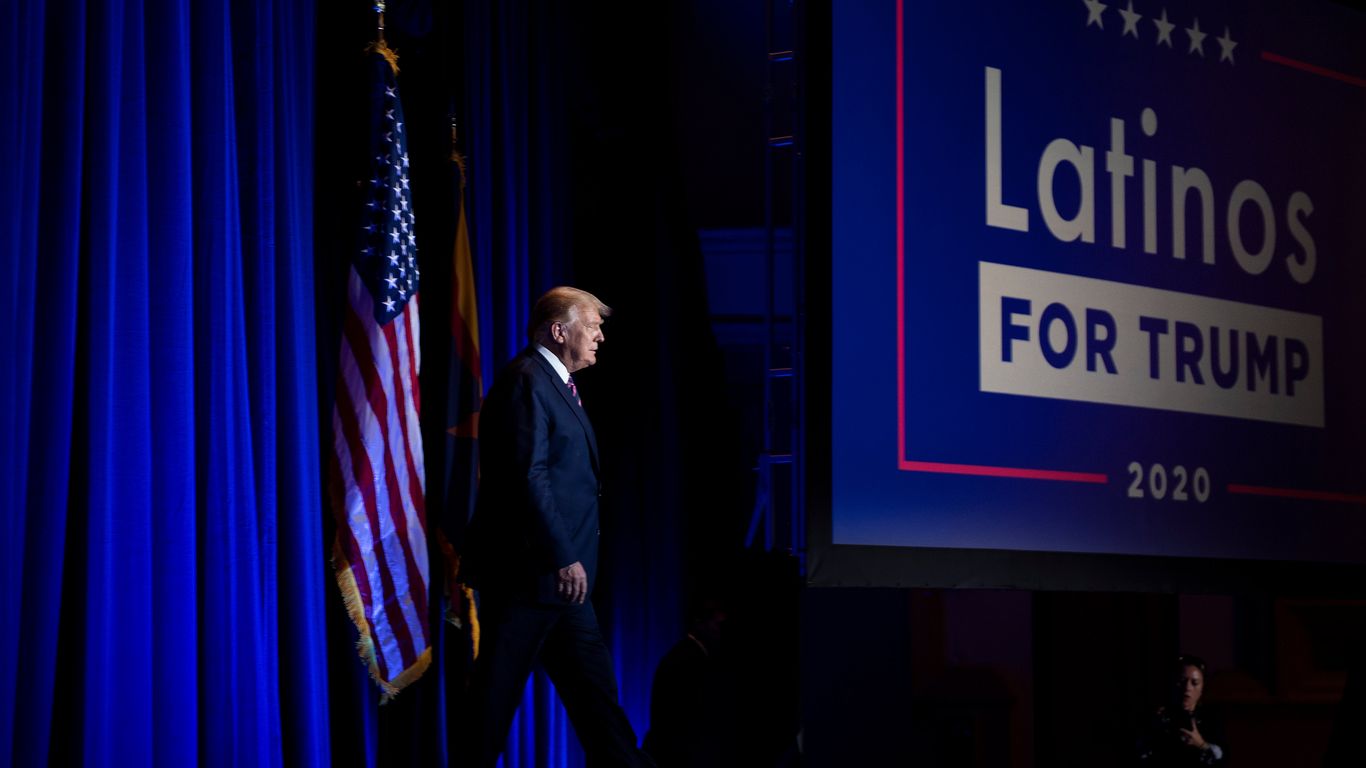
A new analysis of U.S. voters suggests — counterintuitively — that the coronavirus pandemic may have helped drive former President Donald Trump's surprising increase in support from Latinos last November.
The big picture: By shifting Trump's rhetoric from immigration to fears around the economic impact of shutdowns, the virus gave conservative and low-information Latino voters a permission structure to back Trump even if they shunned him in 2016, according to preliminary findings by research firm Equis that were reviewed by Axios.
- Some of these voters favor "the wall" and restrictive immigration policies, but drew a line at Trump's 2016 reference to Mexican immigrants as "rapists" or kids in cages and separating children from their parents, researchers said.
- Some feared economic damage from school and business closures more than getting sick.
Why it matters: The extensive research helps to identify who drove Latino voting shifts, why, and what it may portend for next year's midterms and 2024.
- Since 2019, Equis has done more than 40,000 interviews with Latino voters in a dozen key states.
- Since the election, Equis' Carlos Odio and Stephanie Valencia — both Obama administration veterans — have pored over public data and commissioned their own polls and focus groups to understand the nuances of voter motivation and media consumption among Latinos.
Be smart: Trump and his strategists understood that Latino voters are a more ideologically diverse, persuadable and activate-able than many Democrats assumed.
- Latino Democrats weren't as enthusiastic about Joe Biden as about Hillary Clinton four years before.
- Trump's biggest gains were among conservative Latinos and, surprisingly, among Hispanic women — a group that still overwhelmingly rejected the former president but softened on him in 2020.
Between the lines: Trump also made gains with Latinos across the country, not just in Texas and Florida. These shifts may be partly specific to the candidates and dynamics of 2020, but partly lasting.
By the numbers: Biden won around two-thirds of Latino voters overall, but densely Latino precincts in Massachusetts, New Jersey, Wisconsin, Nevada, Texas and Florida all shifted toward Trump by between 6 and 20 percentage points since 2016.
- In Paterson, New Jersey, Trump improved his raw vote total by 126% from 2016; Biden got 6% fewer raw votes than Clinton.
- Trump surged in Latino-heavy spots in Vegas, winning 51% more votes than he had in 2016, while Biden gained 6%, per Equis' analysis.
- He also made gains in Milwaukee — up 38% while Biden was down 4% — and Arizona's Maricopa County, up 64% compared with a 38% gain for Biden.
Trump's "baseline shift" improvement among Latino voters was bigger and broader than shifts among African Americans, Asian Americans and Pacific Islanders.
- The biggest vote-switchers were Cubans in Florida — 15% of those who voted for Clinton in 2016 went for Trump in 2020, per an Equis/Cuba Study Group post-election survey of voters in Miami-Dade.
- Biden's underperformance was even more dramatic in so-called "LatAm" precincts — non-Cuban or Puerto Rican.
- In other states, vote-switching was less a factor than Trump's ability to turn out new Latino voters. In Nevada they were "less ideological, younger, more foreign-born than regular Trump voters," per Equis.
What they're saying: Fears that Biden would shut down the economy to fight COVID likely helped drive support for Trump, Equis found in its focus groups of Latino voters.
- In a February 2021 focus group in Wisconsin, a 31-year-old Amazon delivery driver and first-time Trump voter said, "[Voting for Trump] suited me because of my job. This year things have gone much better for me. The way he communicates made me hesitate. But I voted for him more for economic reasons."
What's next: Equis plans to test several hypotheses in the coming months.
- A key one is the idea that the intensity of Trump's anti-immigrant rhetoric was a "forcefield" in 2016 that prevented many Latino voters from supporting him even if other aspects of his persona, such as the "Apprentice"-era perception of him as a successful businessman, appealed.
Equis researchers say Democrats must commit to ongoing investment in Latino precincts rather than showing up every two or four years, or for a last-month advertising blitz.
- Trump's campaign took advantage of Democrats' complacency, campaigned relentlessly, and spent money and effort targeting low-information Latino voters on the media channels they use more frequently.
- That includes YouTube, where Latinos were spending twice as much time as non-Latino audiences. Trump flooded the channel with viral content and homepage takeovers.
- YouTube has become a leading source of election news for Latinos, per Equis. 64% of registered Latino voters said they got election information from YouTube. In Florida it was even higher — 74%.
April 02, 2021 at 04:00PM
https://www.axios.com/trump-data-latino-support-49a0f0ed-b244-4b27-86b3-ee022e21f8c1.html
Exclusive: Fresh data reveal how Trump made inroads with Latinos - Axios
https://news.google.com/search?q=fresh&hl=en-US&gl=US&ceid=US:en

No comments:
Post a Comment